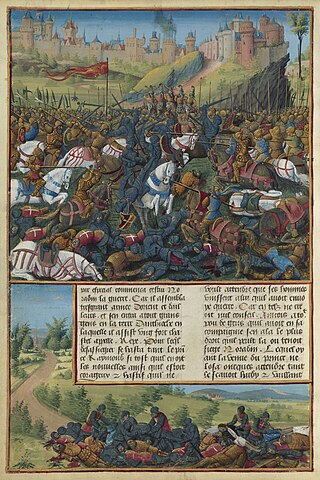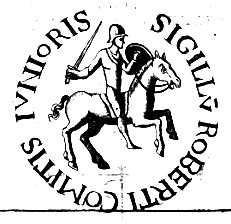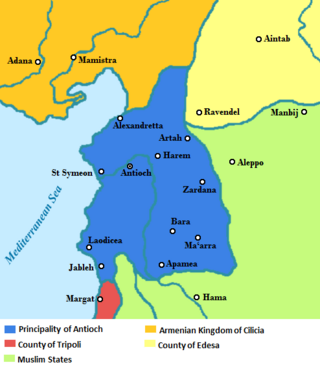The 1090s was a decade of the Julian Calendar which began on January 1, 1090, and ended on December 31, 1099.

The First Crusade (1096–1099) was the first of a series of religious wars, or Crusades, initiated, supported and at times directed by the Latin Church in the medieval period. The objective was the recovery of the Holy Land from Islamic rule. While Jerusalem had been under Muslim rule for hundreds of years, by the 11th century the Seljuk takeover of the region threatened local Christian populations, pilgrimages from the West, and the Byzantine Empire itself. The earliest initiative for the First Crusade began in 1095 when Byzantine emperor Alexios I Komnenos requested military support from the Council of Piacenza in the empire's conflict with the Seljuk-led Turks. This was followed later in the year by the Council of Clermont, during which Pope Urban II supported the Byzantine request for military assistance and also urged faithful Christians to undertake an armed pilgrimage to Jerusalem.

The Second Crusade (1147–1150) was the second major crusade launched from Europe. The Second Crusade was started in response to the fall of the County of Edessa in 1144 to the forces of Zengi. The county had been founded during the First Crusade (1096–1099) by King Baldwin I of Jerusalem in 1098. While it was the first Crusader state to be founded, it was also the first to fall.

Baldwin I was the first count of Edessa from 1098 to 1100 and king of Jerusalem from 1100 to his death in 1118. He was the youngest son of Eustace II, Count of Boulogne, and Ida of Lorraine and married a Norman noblewoman, Godehilde of Tosny. He received the County of Verdun in 1096, but he soon joined the crusader army of his brother Godfrey of Bouillon and became one of the most successful commanders of the First Crusade.

Godfrey of Bouillon was a pre-eminent leader of the First Crusade, and the first ruler of the Kingdom of Jerusalem from 1099 to 1100, although he avoided the title of king, preferring that of prince (princeps) and Advocatus Sancti Sepulchri, or Advocate of the Holy Sepulchre. He was the second son of Eustace II, Count of Boulogne, and Lord of Bouillon, from his mother's inheritance, in 1076. In 1087 Emperor Henry IV confirmed him as Duke of Lower Lorraine, a reward for his support during the Great Saxon Revolt. Along with his brothers Eustace III and Baldwin of Boulogne, Godfrey joined the First Crusade in 1096. He took part in actions at Nicaea, Dorylaeum, and Antioch, before playing a key role during the capture of Jerusalem in 1099. When Raymond IV, Count of Toulouse declined the offer to become ruler of the new kingdom, Godfrey accepted the role and secured his kingdom by defeating the Fatimids at Ascalon a month later, bringing the First Crusade to an end. He died in July 1100 and was succeeded by his brother Baldwin as King of Jerusalem.

Bohemond II was Prince of Taranto from 1111 to 1128 and Prince of Antioch from 1111/1119 to 1130. He was the son of Bohemond I, who in 1108 was forced to submit to the authority of the Byzantine Empire in the Treaty of Devol. Three years later, the infant Bohemond inherited the Principality of Taranto under the guardianship of his mother, Constance of France. The Principality of Antioch was administered by his father's nephew, Tancred, until 1111. Tancred's cousin, Roger of Salerno, managed the principality from 1111 to 1119. After Roger died in the Battle of the Field of Blood, Baldwin II of Jerusalem took over the administration of Antioch. However, he did acknowledge Bohemond's right to personally rule the principality upon reaching the age of majority.

Qiwam al-Dawla Kerbogha, known as Kerbogha or Karbughā, was atabeg of Mosul during the First Crusade and was renowned as a soldier.

The Principality of Antioch was one of the Crusader states created during the First Crusade which included parts of modern-day Turkey and Syria. The principality was much smaller than the County of Edessa or the Kingdom of Jerusalem. It extended around the northeastern edge of the Mediterranean, bordering the County of Tripoli to the south, Edessa to the east, and the Byzantine Empire or the Kingdom of Armenia to the northwest, depending on the date.

Robert II, Count of Flanders was Count of Flanders from 1093 to 1111. He became known as Robert of Jerusalem or Robert the Crusader after his exploits in the First Crusade.

The siege of Antioch took place during the First Crusade in 1097 and 1098, on the crusaders' way to Jerusalem through Syria. Two sieges took place in succession. The first siege, by the crusaders against the city held by the Seljuk Empire, lasted from 20 October 1097 to 3 June 1098. The second siege, of the crusader-held city by a Seljuk relieving army, lasted three weeks in June 1098, leading to the Battle of Antioch in which the crusaders defeated the relieving army led by Kerbogha. The crusaders then established the Principality of Antioch, ruled by Bohemond of Taranto.

Gaston IV was viscount of Béarn from 1090 to 1131. He was called le Croisé––the Crusader––because of his participation in the First Crusade as part of the army of Raymond of Saint-Gilles.

The Crusades were a series of religious wars initiated, supported, and sometimes directed by the Christian Latin Church in the medieval period. The best known of these military expeditions are those to the Holy Land in the period between 1095 and 1291 that were intended to conquer Jerusalem and its surrounding area from Muslim rule. Beginning with the First Crusade, which resulted in the conquest of Jerusalem in 1099, dozens of military campaigns were organised, providing a focal point of European history for centuries. Crusading declined rapidly after the 15th century.
Zahir al-Din Toghtekin or Tughtekin, also spelled Tughtegin, was a Turkoman military leader, who was emir of Damascus from 1104 to 1128. He was the founder of the Burid dynasty of Damascus.
William the Carpenter, viscount of Melun, was a French nobleman who participated in the Reconquista in Spain and on the First Crusade. He was notorious for defecting from the army both in Spain and on the crusade, but he was also known for his strength in battle, whence he earned his nickname "the Carpenter." He returned to the Holy Land after the crusade, and nothing further is known of his life or death.

St Symeon or Port St Symeon was the medieval port for the Frankish Principality of Antioch, located on the mouth of the Orontes River. It may be named after Saint Simeon Stylites the Younger, who dwelt on a mountain only six miles from St Symeon, or the original Saint Simeon Stylites, who was buried in Antioch.
The army of Raymond of Saint-Gilles was one of the first to be formed after Pope Urban II called for the First Crusade. Raymond formed a Provençal army and left his County of Toulouse in October 1096, traveling over the land route. He was the only leader of a major army that did not swear an oath of fealty to Byzantine emperor Alexius I Komnenos.
The Expedition to Samosata was undertaken by the future Baldwin I of Jerusalem following his ascension to co-regent of Edessa as a part of the First Crusade. His main goal was to eliminate the Emirate of Samosata as a commercial and military rival of the Edessene state. The expedition was carried out from 14 to 20 February 1098.
Ahmed ibn Merwan was an Arab lieutenant in Kerbogha's army at the time of the First Crusade.
Rainald III was the count of Toul in Upper Lotharingia in the late 11th century. He was the son of Frederick I, count of Astenois.
The Crusade of 1129 or the Damascus Crusade was a military campaign of the Kingdom of Jerusalem with forces from the other crusader states and from western Europe against the Emirate of Damascus. The brainchild of King Baldwin II of Jerusalem, the crusade failed to meet its military objectives. Its diplomatic preliminaries, however, secured the succession to the throne of Jerusalem and papal backing for the Knights Templar.













